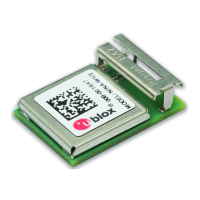NINA-W1 series - User Manual
Handling and soldering
No natural rubbers, hygroscopic materials or materials containing asbestos are employed.
4.1 Packaging, shipping, storage and moisture preconditioning
For information pertaining to reels, tapes or trays, moisture sensitivity levels (MSL), shipment and
storage, as well as drying for preconditioning refer to NINA-W1 series Data Sheets,
and u-blox
Package Information Guide.
4.2 Handling
The NINA-W1 series modules are Electro-Static Discharge (ESD) sensitive devices and require
special precautions during handling. Particular care must be exercised when handling patch
antennas, due to the risk of electrostatic charges. In addition to standard ESD safety practices, the
following measures should be taken into account whenever handling the receiver:
Unless there is a galvanic coupling between the local
GND (i.e. the work table) and the PCB GND, then the
first point of contact when handling the PCB must
always be between the local GND and PCB GND.
Before mounting an antenna patch, connect ground
of the device
When handling the RF pin, do not come into contact
with any charged capacitors and be careful when
contacting materials that can develop charges (e.g.
patch antenna ~10 pF, coax cable ~50-80 pF/m,
soldering iron, …)
To prevent electrostatic discharge through the RF
input, do not touch any exposed antenna area. If
there is any risk that such exposed antenna area is
touched in non ESD protected work area, implement
proper ESD protection measures in the design.
When soldering RF connectors and patch antennas
to the receiver’s RF pin, make sure to use an ESD
safe soldering iron (tip).
4.3 Soldering
4.3.1 Reflow soldering process
The NINA-W1 series modules are surface mount modules supplied on a FR4-type PCB with gold
plated connection pads and are produced in a lead-free process with a lead-free soldering paste. The
bow and twist of the PCB is maximum 0.75% according to IPC-A-610E. The thickness of solder resist
between the host PCB top side and the bottom side of the NINA-W1 series module must be
considered for the soldering process.
The module is compatible with industrial reflow profile for RoHS solders. Use of "No Clean" soldering
paste is strongly recommended.
The reflow profile used is dependent on the thermal mass of the entire populated PCB, heat transfer
efficiency of the oven, and particular type of solder paste used. The optimal soldering profile used
has to be trimmed for each case depending on the specific process and PCB layout.

